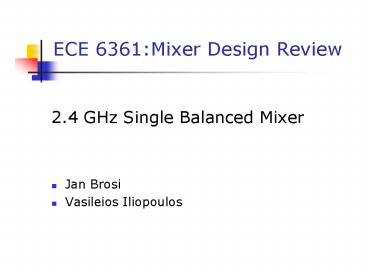ECE 6361:Mixer Design Review
1 / 17
Title:
ECE 6361:Mixer Design Review
Description:
Mixer harmonic balance simulation with 8 orders and gradient method optimization ... Changes didn't have a significant effect on the simulated mixer performance ... –
Number of Views:213
Avg rating:3.0/5.0
Title: ECE 6361:Mixer Design Review
1
ECE 6361Mixer Design Review
- 2.4 GHz Single Balanced Mixer
- Jan Brosi
- Vasileios Iliopoulos
2
Project Objectives I
3
Project Objectives II
- Board4-layer PPE (1.7x2.6 inches)
- Schottky diodes dual series connected
4
Physical Construction I
- Reduced-size rat-race balun with coupled lines on
different layers - Radial stubs for matching at RF/LO frequency
- Lumped elements for matching at IF and for
DC-return
27mm
5
Physical Construction II
- Board parameters
- er2.85 0.5
- tand0.002-0.003
- core thickness1mm
- resin thickness50µm
- copper thickness12µm
- Diodes
- Zetex ZC2812ECT
- IS9.5nA, RS16.3Ohm
- N1.27, Cj01.1pF
- Lumped Elements
- Toko 2021 series chip inductors
- Panasonic chip capacitors
6
Model Description Simulation
- Simulation with Agilent ADS using a combination
of Multilayer Microstrip models - Diode Model ADS P-N diode model with parameters
from manufacturers data sheet - Inclusion of parasitic elements (bends, steps, T-
junctions, vias, pads, parasitics of lumped
elements). - Balun design with S-parameter simulation and
gradient method optimization for best performance - Mixer harmonic balance simulation with 8 orders
and gradient method optimization
7
Simulation Results
- Simulated circuit meets all specs
8
Conversion Loss Measurement
- Measurement of conversion loss in down-conversion
using the frequency offset function of HP89441
Network analyzer - The LO port is fed by E4432 Signal Generator with
8.5dBm input power (assuming 0.5 dB cable loss) - Use of a low-pass filter at the input port of the
Network analyzer to ensure better phase-locking - The filter response was calibrated out
- Accuracy of the measurement
- Signal generator 0.5dB
- Network analyzer 0.2dB
- Total accuracy 0.7dB
9
Conversion Loss Measurement Results
- Conversion loss increases with increasing
LO-frequency
10
Spurious Isolation Measurement
- Measurement of spurious signals and LO-RF
isolation for up-conversion using HP8994E
Spectrum Analyzer. - Measurement of LO-IF isolation for
down-conversion - Sweep over the LO frequency range
- Accuracy of the spurious signals measurement
- Relative accuracy of spectrum analyzer 0.5dB
- Accuracy of the LO-RF isolation measurement
- Absolute accuracy of spectrum analyzer 1dB
- Signal generator 0.5dB
- Total accuracy 1.5dB
11
Spurious Isolation Measurement Graph
LO-IF
LO
RF
LO-2IF
LO2IF
LO-3IF
LO3IF
LO4IF
12
Spurious Measurement Results
13
Isolation Measurement Results
14
Changes made to the Circuit
- Circuit assembled as designed has bad performance
and does not meet any of the specs - Slight change of inductor capacitor values and
interchange of their position increased mixer
performance - The mixer seems to be shifted to lower
frequencies, it works much better at fLO1.9 GHz - Thus it was tried to reduce the size of the mixer
- Coupled lines were shortened by use of new vias
- Line edges were smoothened with copper material
to reduce length - Resulting circuit had best performance and was
used for measurements
15
Comparison to Simulations
- The measurements dont match with the simulations
- Trying to fit ADS-model to measurements by change
of dielectric constant, distance between layers,
coupled line offset, length and width of lines,
stub length and width, vias and pads, losses and
diode model. - This should account for production tolerances and
previously not considered effects - Changes didnt have a significant effect on the
simulated mixer performance - Indication that ADS multilayer-model is not
accuarate
16
Summary Conclusions I
- A single-balanced mixer using a reduced-size
rat-race balun with mulilayer coupled-lines was
designed, simulated, fabricated and measured - Great differences between model and measurements
of the produced mixer occurred - Performance could be increased by change of
lumped elements and reducing the size of lines - Specifications for Conversion loss are almost
met, for Isolation and some spurious signals not - Re-simulation was not successful
17
Summary Conclusions II
- The ADS multilayer-model does not seem to work
well in our case, another software or model
should be tried - Board parameters like layer thickness and
dielectric constant should be reevaluated - The mixer works much better at lower frequencies,
the balun seems to be downshifted - For the next production cycle, the line lengths
should be decreased to account for that































